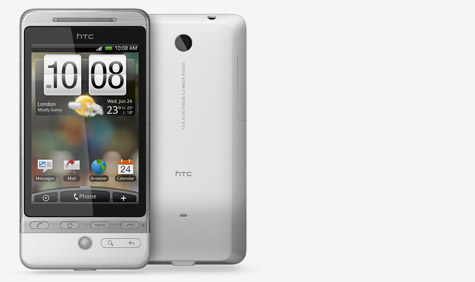HTC Hero handset

Taiwanese company HTC launch its new handset, the Hero, the first device to use HTC's specially customised version of Android.

Few companies have benefited from the touch screen boom as much as HTC. Just a few years ago, this Taiwanese engineering giant was unknown to almost everyone but the other manufacturers who used HTC's expertise to manufacture a whole raft of devices from laptops to phones.
Under the leadership of CEO Peter Chou, HTC has undergone a total revolution, devoting itself to pushing the technological envelope and building its own-name brand (the acronym sounds snappier than the rather anodyne High Tech Computer Corp). Now valued at around $12bn, HTC's 9000 employees are split 60/40 between manufacturing and R+D.
The latest device to emerge from the labs consolidates the company's claim to be at the forefront of mobile design. As well as making Windows Mobile phones - beloved by the corporate crowd - HTC was one of the companies that got into bed with Google's Open Handset Alliance, helping pave the way for the first truly open standard mobile operating system, Android, released last year. It also helps that HTC manufactures the G1, the phone that kick-started Google's assault on Apple's handheld hegemony.
Wallpaper* met up with Horace Luke, HTC's globe-trotting Chief Innovation Officer. In his three years at the company(after a decade spent working for Microsoft), Luke has helped form the current product portfolio, jetting between four design studios (two in Taiwan, as well as San Francisco and Seattle) in the search for the perfect combination of form factor and software. The company drives 20% of profits straight back into R&D, keeping Luke on his toes as he tries to divine the next big thing in phone design.
'The marketplace has shifted from hardware then software to a product experience, a holistic way of experiencing a phone,' Luke explains. 'We're about delivering something that is different. In the last two to three years we've really matured, especially with the Touch Diamond [launched in 2006]'. This week's announcement of the HTC Hero goes a long way towards justifying Luke's desire 'to pioneer industry trends.'
The Hero goes hand in hand with what the company calls 'HTC Sense', 'a user experience that puts you at the centre of design decisions and personalities.' In a world of apps, widgets, endless streams of media and constant contact through social networkign, it would be a foolish handset designer that eschews the consumer desire to tweak and customise their own devices.
Receive our daily digest of inspiration, escapism and design stories from around the world direct to your inbox.
'We called it Sense because it works intuitively,' explains Luke, and to illustrate his point he pulls out the HTC Hero handset, the first device to use HTC's specially customised version of Android. The Hero is slim and elegant, with a little kink at the base, rather like the G1. It's attractive without being self-consciously styled. 'We're not designing an icon,' Luke says, perhaps making a sly dig at their design-obsessed rivals.
That's not to say the Hero isn't designed – far from it. From the special matt paint – with baked-in Teflon coating to repel marks – to the myriad widget styles available for every aspect of the operating system, each animating smoothly and swiftly across the bright screen, the attention to detail is paramount. For Horace Luke, this level of hands-on obsession is what design is all about: he cites how long it took to tune the special twin microphone and dual speaker set-up on the new Touch phone – so you can always hear the other end of the call perfectly – 'I spent three months of my life in the sound labs.'
Like all of HTC's Android phones, the Hero will be 100% compatible with the steady stream of Widgets available for the operating system. Straight out of the stylish box (which has been styled to be fully recyclable and cut down on shipping space) the Hero demonstrates 'complete flexibility,' aggregating incoming information via contact names, not individual email accounts. 'Things should be people-centric,' Luke says, 'it's relationships that make you love your device more.'
As well as the ability to aggregate multiple email accounts, there are applications like Footprints, which acts as a virtual map pin, allowing you to note down a location and add notes and media before sharing it with friends. The browser ships with full Flash support (so you'll be able to sample wallpaper.com in all its glory) as well as a fuzzy logic typing system that Luke promises is the equal of any rival system. A 5mb camera, 3.5 inch headphone jack and microSD memory card slot complete the multimedia package. As you'll probably have guessed, the Hero isn't pitched at the Blackberry-dependent business user. This is a social phone, a physical object that consolidates the myriad social networking opportunities of modern life.
Just like the auto industry, there's a long lead time for mobile phones, meaning that the development teams are well into the next decade's devices. Most of the ideas behind HTC's devices are cooked up in what Luke calls the Magic Lab, a 65-strong R&D team in Taiwan. 'It's like a little start-up,' he says, 'they're tasked to fail fast. They probably have a 5% success rate – they kill ideas quickly and commercialise the good ones.'
Luke won't be drawn on what to expect in the next few years, beyond even more of a focus on intuitive design and reactive sensors. 'Design is not about a big bang theory,' he says, 'it's when you discover a core tenet of how people live. We no longer talk about just hardware or software – this is a holistic product. Phones are becoming a definitive part of us. If you leave home without your wallet you probably wouldn't go home to get it, but your phone…' Our mobile addiction looks set to continue.
Jonathan Bell has written for Wallpaper* magazine since 1999, covering everything from architecture and transport design to books, tech and graphic design. He is now the magazine’s Transport and Technology Editor. Jonathan has written and edited 15 books, including Concept Car Design, 21st Century House, and The New Modern House. He is also the host of Wallpaper’s first podcast.
-
 The Bombardier Global 8000 flies faster and higher to make the most of your time in the air
The Bombardier Global 8000 flies faster and higher to make the most of your time in the airA wellness machine with wings: Bombardier’s new Global 8000 isn’t quite a spa in the sky, but the Canadian manufacturer reckons its flagship business jet will give your health a boost
-
 A former fisherman’s cottage in Brittany is transformed by a new timber extension
A former fisherman’s cottage in Brittany is transformed by a new timber extensionParis-based architects A-platz have woven new elements into the stone fabric of this traditional Breton cottage
-
 New York's members-only boom shows no sign of stopping – and it's about to get even more niche
New York's members-only boom shows no sign of stopping – and it's about to get even more nicheFrom bathing clubs to listening bars, gatekeeping is back in a big way. Here's what's driving the wave of exclusivity